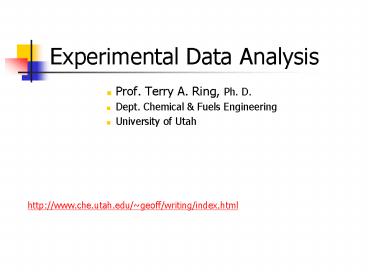Experimental Data Analysis PowerPoint PPT Presentation
1 / 22
Title: Experimental Data Analysis
1
Experimental Data Analysis
- Prof. Terry A. Ring, Ph. D.
- Dept. Chemical Fuels Engineering
- University of Utah
http//www.che.utah.edu/geoff/writing/index.html
2
Making Measurements
- Choice of Measurement Equipment
- Accuracy systematic error associated with
measurement. - Precision random error associated with
measurement.
3
Definitions
- Error the difference between the measured
quantity and the true value. - The true value is not known!!!
- So how do you calculate the error??
- Random errors - the disagreement between the
measurements when the experiment is repeated - Is repeating the measurement on the same sample a
new experiment? - Systematic errors - constant errors which are the
same for all measurements. - Bogus Data mistake reading the instrument
4
Random Error Sources
- Judgement errors, estimate errors, parallax
- Fluctuating Conditions
- Digitization
- Disturbances such as mechanical vibrations or
static electricty caused by solar activity - Systematic Error Sources
- Calibration of instrument
- Environmental conditions different from
calibration - Technique not at equilibrium or at steady state.
5
Statistics
- Mean xM
- Deviation xi-xM
- Standard Deviation ?
- Confidence level or uncertainty,
- 95 confidence 1.96 ?
- 99 confidence 2.58 ?
- Please note that Gaussian distributions do not
rigorously apply to particles- log-normal is
better. - Mean and standard deviation have different
definitions for non-Gaussian Distributions
6
Comparison of means Students t-test
- v n1n2-2
- use the t-value to calculate the probability, P,
that the two means are the same.
7
Compare Two Instruments Measuring the Same
Concentration
8
T-test Cont.
9
Compare Two Instruments Measuring the Same
Concentration
10
T-test - Cont
11
Estimating Uncertainties or Estimating Errors in
Calculated Quantities with Partial Derivatives
- Gf(y1,y2,y3,)
http//www.itl.nist.gov/div898/handbook/mpc/sectio
n5/mpc55.htm
12
(No Transcript)
13
(No Transcript)
14
Way around the Partial Derivatives
This approach applies no matter how large the
uncertainties (Lyons, 1991). (i) Set all xi
equal to their measured values and calculate f.
Call this fo. (ii) Find the n values of f
defined by fi f(x1,x2,...,xisi,...,xn)
(11) (iii)
Obtain sf from
(12) If the uncertainties are
small this should give the same result as (10).
If the uncertainties are large, this numerical
approach will provide a more realistic estimate
of the uncertainty in f. The numerical approach
may also be used to estimate the upper and lower
values for the uncertainty in f because the fi in
(11) can also be calculated with xi? replaced by
xi-?.
15
Now try the same calculation using the spread
sheet method. The dimensionless form of (12) is
(after taking the square root)
(17) The propagated
fractional uncertainties using (15) and (17) are
compared in Table 4. A further advantage of
the numerical approach is that it can be used
with simulations. In other words, the function f
in (12) could be a complex mathematical model of
a distillation column and f might be the mole
fraction or flow rate of the light component in
the distillate. Table 4. Uncertainties in Gas
Velocity Calculated from (15) and (17)
See web page with sample calculation done with
Excel
16
Fitting Data
- Linear Equation linear regression
- Non-linear Equation
- Linearize the equation- linear regression
- Non-linear least squares
17
Rejection of Data Points
- Maximum Acceptable Deviations (Chauvenets
Criterion)
18
Example
- xi-xM/??8.9-8.2?/0.32.33
- xi-xM/??7.9-8.2?/0.31.0
19
Regression
- Linear Regression
- good for linear equations only
- Linearize non-linear equation first
- linearization leads to errors
- Non-linear Regression
- most accurate for non-linear equations
- See Mathcad example
20
Residence Time Measurements
T
T
Time(min)
Time(min)
T(To-Tin)exp(-t/tau)Tin
21
Non-Linear Fit Linearized Eq. Fit Flow Calc.s
Temperature(C)
Time (min)
22
Results

